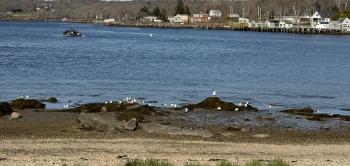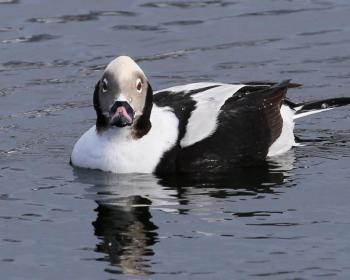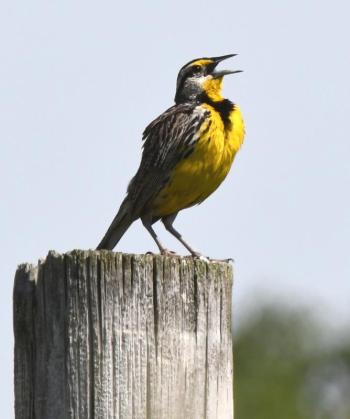Departures and Arrivals
We’ve been serenaded most mornings this week by a loud, whistled “Old Sam Peabody-Peabody-Peabody”—the sweet sound of a white-throated sparrow tuning up the song that he will soon be singing incessantly from the depths of an opening in a fragrant spruce-fir forest somewhere farther north. Although it’s hard to say if this one is the same, we’ve had two white-throated sparrows that have spent the entire winter in and around the bushes and feeders in our yard.
A bird that we haven’t seen in the neighborhood since last fall, though, has also been welcoming us with song in the mornings. In this case it’s the tiny, greenish-backed ruby-crowned kinglet. Hidden in the safety of our neighbor’s cedar tree, it belts out a rollicking song that sounds like it should be from a much larger bird. It’s just stopping off here for a short time on its way north.
On a trip to the coast over the weekend, we were delighted to roll down the windows at Pemaquid Harbor and hear the wonderful cacophony of a newly arrived flock of laughing gulls cavorting along the shore. Across the way in a little strip of muddy shore and saltmarsh were four greater yellowlegs. Later they picked up and flew by us, giving their resonant mellow “tu-tu-tu” calls, which we wrote about recently. Perhaps they had spent the winter in South America like the one we wrote about.
We were surprised to see a number of Arctic and Boreal breeding ducks that hadn’t left their Maine coast wintering grounds yet. We saw long-tailed ducks that will be nesting this summer in the Arctic, and tiny buffleheads that will be doing the same in the Boreal Forest region of Canada and Alaska. Black scoters, the males jet black with bright orange bill knobs and females with their pale cheeks, bobbed in with the common eiders just off the ledges at Pemaquid Point. Later, a few surf scoters and white-winged scoters flew by.
A quick stop at the former Brunswick Naval Air Station blessed us with the clear, whistled song of an eastern meadowlark. We could see it sitting on a sign, some distance off near the runway. That’s a grassland-loving bird that spends the winter in the southern U.S. and has arrived to set up breeding territory. We expect it should be there through the summer.
While walking the dog last week we heard, from the top of a single tall spruce tree, an exuberantly singing pine siskin. We haven’t had many pine siskins around this winter but there seems to have been a little surge in the numbers this spring. Presumably, these are birds starting to move north again to nest. This bird was particularly interesting as it interspersed its various twitterings and “shree” calls with imitations of what sounded like boreal chickadee and later, evening grosbeak. Presumably these are sounds that this bird learned while on the breeding grounds in spruce-fir habitat where those two species occur regularly. That would be a place quite distant from our neighborhood!
Jeffrey V. Wells, Ph.D., is a Fellow of the Cornell Lab of Ornithology and Vice President of Boreal Conservation for National Audubon. Dr. Wells is one of the nation's leading bird experts and conservation biologists. He is a coauthor of the seminal “Birds of Maine” book and author of the “Birder’s Conservation Handbook.” His grandfather, the late John Chase, was a columnist for the Boothbay Register for many years. Allison Childs Wells, formerly of the Cornell Lab of Ornithology, is a senior director at the Natural Resources Council of Maine, a nonprofit membership organization working statewide to protect the nature of Maine. Both are widely published natural history writers and are the authors of the popular books, “Maine’s Favorite Birds” (Tilbury House) and “Birds of Aruba, Bonaire, and Curaçao: A Site and Field Guide,” (Cornell University Press).





























